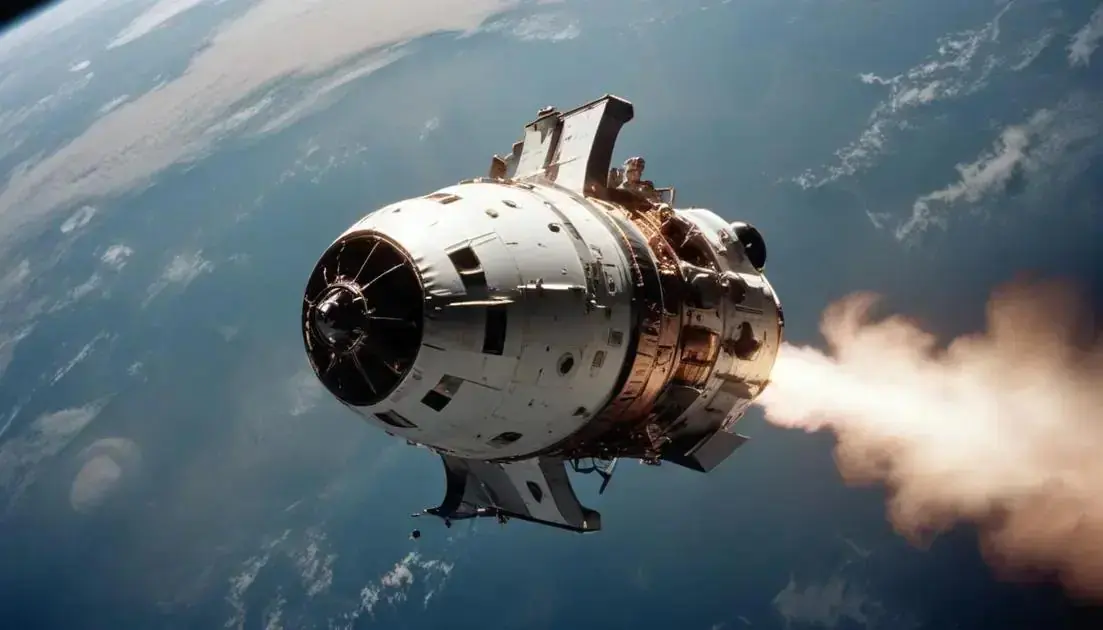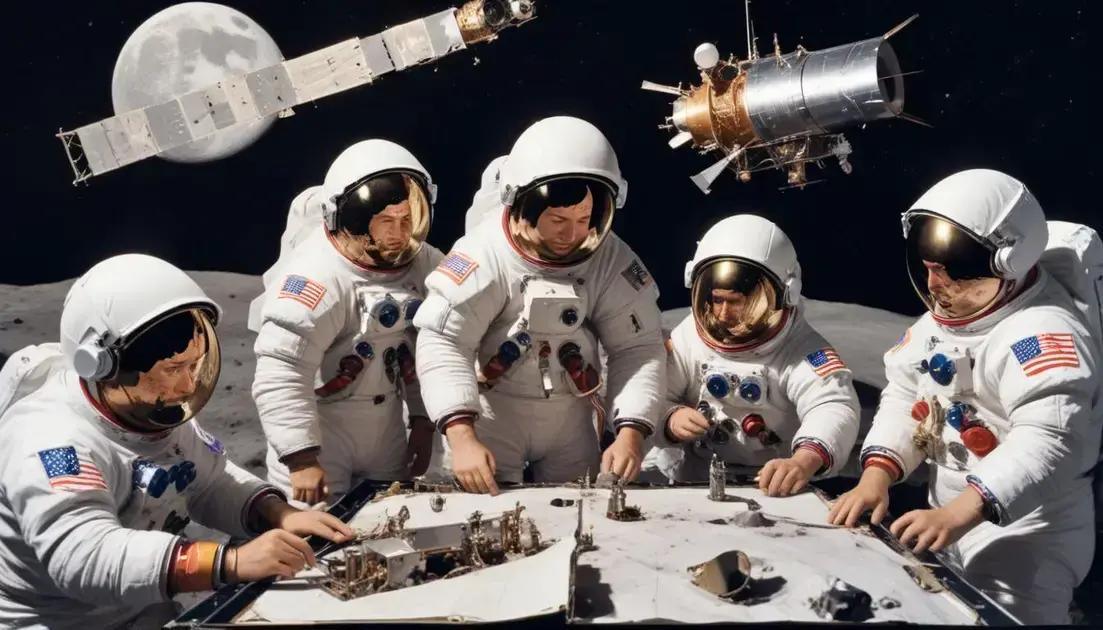
Apollo 13: failure turned into triumph
The Apollo 13 mission is a remarkable example of triumph in adversity, showcasing the bravery and teamwork of the astronauts and NASA ground control. Following a critical failure in space, the crew faced immense challenges but used innovative problem-solving and effective communication to survive. Key lessons from this incident emphasize the importance of preparation, adaptability, and collaboration in overcoming obstacles, highlighting the human spirit’s resilience in times of crisis.
Have you ever wondered how a single phrase, “Houston, we’ve had a problem,” became a symbol of resilience? In the story of Apollo 13, we find more than just a space mission; we witness a testament to human ingenuity and courage.
Overview of the Apollo 13 mission and its initial goals
The Apollo 13 mission began with great excitement. It was planned as the third crewed mission to land on the Moon. Astronauts James Lovell, Jack Swigert, and Fred Haise were ready for this adventure. They aimed to explore the Moon’s Fra Mauro highlands. This area was thought to have interesting geological features.
Everything started well. The launch on April 11, 1970, from Kennedy Space Center was successful. The crew was in high spirits as they made their way to space. They had planned a lot to ensure everything would go smoothly. But just two days later, trouble struck.
During their journey, an explosion in the service module changed everything. The oxygen tank blew up, leading to a loss of power. The crew faced serious challenges. They had to work closely with the teams at NASA. Together, they figured out how to bring the astronauts back safely.
Despite the unexpected crisis, the initial goals of the Apollo 13 mission were still crucial. The team aimed to collect lunar samples and conduct scientific experiments. Although the mission didn’t go as planned, teamwork and quick thinking became the mission’s true focus.
It’s important to remember that the spirit of exploration was alive then. Apollo 13 reminded us of the risks of space travel. However, it also showed the ability to adapt and problem-solve. The mission’s legacy continues to inspire future generations in the field of space exploration.
The critical failure that changed everything
The Apollo 13 mission faced a major crisis just days after launch. On April 13, 1970, an explosion occurred in one of the oxygen tanks. This critical failure changed everything for the crew. The mission quickly shifted from exploration to survival.
The explosion damaged the service module. This caused a loss of power and oxygen. The crew had to act fast. They had to conserve resources to stay alive. It was a tough situation that required quick thinking.
The astronauts, James Lovell, Jack Swigert, and Fred Haise, used their training and teamwork. They had to work closely with NASA’s ground control experts. Communication between the crew and mission control was vital. Everyone had to be on the same page to find solutions.
Engineers on the ground faced challenges, too. They needed to create a plan to bring the crew home safely. They designed new procedures using limited resources aboard the spacecraft. The teamwork showed human resilience in the face of danger.
This incident became a turning point. It highlighted the risks of space travel and the importance of quick problem-solving. Apollo 13’s critical failure taught valuable lessons about determination and innovation.
The response from NASA and ground control
When the explosion happened on Apollo 13, NASA faced an urgent situation. The crew needed immediate help. Ground control quickly shifted focus from a lunar landing to a rescue operation. This change was crucial for the safety of the astronauts.
Nasa’s team sprang into action. They assessed the damage and created plans. Engineers worked around the clock to come up with solutions. They used a small team, but their efforts were amazing. Everyone knew the stakes were high.
Communication played a key role. The astronauts and mission control stayed in touch continuously. This teamwork helped them solve problems. Engineers guided the crew step by step through each task. They shared vital information using clear instructions.
They worked on creating a makeshift way to generate power. This was essential to keep systems running. The ground team also helped the crew save oxygen and water. Together, they developed creative solutions with limited resources aboard Apollo 13.
This incident showed the strength of human collaboration. NASA’s quick response ensured that the astronauts had a fighting chance. Their dedication, skill, and teamwork became legendary as the rescue unfolded.
Heroic efforts of the astronauts and crew
The astronauts on Apollo 13 showed incredible bravery during the crisis. Facing danger, they had to stay calm and focused. James Lovell, Jack Swigert, and Fred Haise worked tirelessly to solve problems. They knew their lives depended on their teamwork.
Each crew member played a vital role. Lovell remained the leader, guiding his team with confidence. Swigert operated the spacecraft’s systems and helped navigate. Haise focused on keeping the crew safe and managing resources.
They had to improvise with what they had. Using duct tape, they created a vital air filter. This was necessary to remove carbon dioxide from the cabin. Their quick thinking helped them breathe easier and stay alert.
Throughout the journey, the astronauts communicated with ground control. This teamwork was crucial. They relied on NASA for support and guidance. Together, they mapped out steps to bring Apollo 13 home safely.
Their efforts demonstrated true heroism. The astronauts faced life and death, yet they never gave up. They showed that human spirit and cooperation can lead to success, even in the toughest situations.
Lessons learned from the Apollo 13 incident
The Apollo 13 incident taught us many important lessons. First, teamwork is vital during a crisis. The astronauts and ground control had to work together closely. Their communication was key to solving problems and ensuring safety.
Another lesson is the value of preparation. NASA had trained the crew for emergencies. This training helped them stay calm and focused when things went wrong. They knew what to do and how to adjust their plans.
Flexibility is also crucial. The crew had to adapt quickly to unexpected challenges. They used their creativity to find solutions. For instance, they invented a way to filter air using spare parts.
The incident highlighted the importance of safety in space travel. Engineers and scientists continue to learn from Apollo 13. They use these lessons to improve future missions and ensure astronauts’ safety.
Most importantly, this event showed the power of human spirit. People can come together and overcome extreme challenges. Apollo 13 remains a powerful example of courage and resilience in difficult times.
Conclusion: Triumph in adversity
Apollo 13 is a powerful story of triumph in adversity. The mission faced enormous challenges, yet the crew remained strong. Their courage and teamwork made all the difference. Together with ground control, they found solutions under intense pressure.
This incident highlighted how teamwork can overcome obstacles. It showed the importance of staying calm during a crisis. The astronauts focused on what they could control and made smart decisions.
This story continues to inspire many people today. It reminds us that challenges can lead to growth. The lessons from Apollo 13 encourage others to face their difficulties head-on. They teach us to see challenges as opportunities.
The mission’s legacy lives on, showcasing human resilience. It demonstrates what we can achieve when we work together. Apollo 13 stands as a testament to the strength of the human spirit in the face of adversity.
Conclusion
In conclusion, the story of Apollo 13 teaches us important lessons about resilience and teamwork. When faced with tough challenges, the crew and NASA worked together to find solutions. Their courage showed that even in difficult times, we can overcome obstacles.
This mission highlights the power of communication and quick thinking. The astronauts’ ability to adapt and innovate made a real difference. It reminds us that working together can lead to success, no matter the odds.
Overall, Apollo 13 inspires us to face our challenges head-on. It proves that triumph in adversity is possible with determination and collaboration. As we look to the future, we can carry these lessons with us in our own lives.


